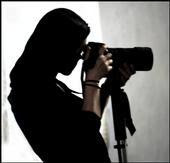DSLRs have a great advantage over 35mm cameras: film speed can be changed on demand. With 35mm cameras what ever speed of film roll you loaded, you would have to finish it before changing the speed by loading a new roll. So, what is ISO and what all those numbers mean?
ISO refers to sensor's sensitivity to light (in other words, how much light is absorbed by the camera sensor). The lower the number (slow speed), the less sensitive it is. The higher the number (high speed), the more sensitive it is. The camera is equipped to auto select ISO settings, however, those decisions may not always meet the photographer's expectations. Knowing which settings to select and when can improve the quality of images dramatically.
There is no free lunch, and ISO settings have trade-offs to be taken into consideration:
The slower the ISO, the longer exposure is required to record the image. The faster the ISO, the shorter time it takes to record the image. So, speeding up your settings allows you to use faster shutter speeds. This is especially handy in low-light conditions and to counter-act camera shake (covered in previous post).
- BUT -
Using higher ISO speeds introduces noise (aka film grain), and causes your image quality to degrade. Where using lower ISO speeds yields to clearer images. So, choosing your custom setting you have to be mindful of speed vs. quality balance.
Selecting ISO speed depends on light conditions. As a general rule of thumb, there are five "benchmark" speeds: 100, 200, 400, 800, 1600 (most camera's ISO options may exceed this range). ISO speed is increased as light availability decreases. The less light, the higher the ISO. "Ideal" speed/light matching is then as follows:
ISO refers to sensor's sensitivity to light (in other words, how much light is absorbed by the camera sensor). The lower the number (slow speed), the less sensitive it is. The higher the number (high speed), the more sensitive it is. The camera is equipped to auto select ISO settings, however, those decisions may not always meet the photographer's expectations. Knowing which settings to select and when can improve the quality of images dramatically.
There is no free lunch, and ISO settings have trade-offs to be taken into consideration:

The slower the ISO, the longer exposure is required to record the image. The faster the ISO, the shorter time it takes to record the image. So, speeding up your settings allows you to use faster shutter speeds. This is especially handy in low-light conditions and to counter-act camera shake (covered in previous post).
- BUT -
Using higher ISO speeds introduces noise (aka film grain), and causes your image quality to degrade. Where using lower ISO speeds yields to clearer images. So, choosing your custom setting you have to be mindful of speed vs. quality balance.
Selecting ISO speed depends on light conditions. As a general rule of thumb, there are five "benchmark" speeds: 100, 200, 400, 800, 1600 (most camera's ISO options may exceed this range). ISO speed is increased as light availability decreases. The less light, the higher the ISO. "Ideal" speed/light matching is then as follows:
- ISO 100: abundant light conditions (e.g. bright sunny day)
- ISO 200: mild light conditions (e.g. partly cloudy sunny day)
- ISO 400: moderate shade or heavy cloud overcast
- ISO 800: indoors or early evening
- ISO 1600: night photography
Your camera auto selection will roughly reference these lighting conditions when selecting the ISO settings. Most of the times these setting will be adequate, however, there are times where you can "afford" to select a different speed. You can complement your shutter and aperture settings by taking into account ISO exposure factor. For example, when shooting in low light conditions but have an advantage of using a tripod and camera shake is not a concern, lower ISO setting can be chosen to obtain less noisy images. Or when photographing children or animals in a good lighting conditions, the shutter speeds may be deliberately increased as photography subjects move fast and unpredictably, so upping the ISO to 400 instead of 100 may be a good call. Deliberately upping your ISO settings may also allow you to increase your depth of field by stopping down your aperture settings (or vice versa). Hence, knowing how ISO speed works can produce good image results, extend flexibility to aperture/shutter settings and help control image exposure.

No comments:
Post a Comment